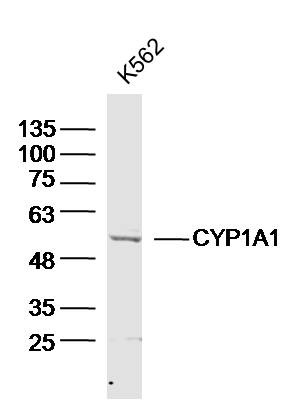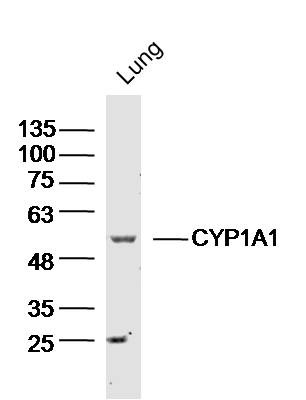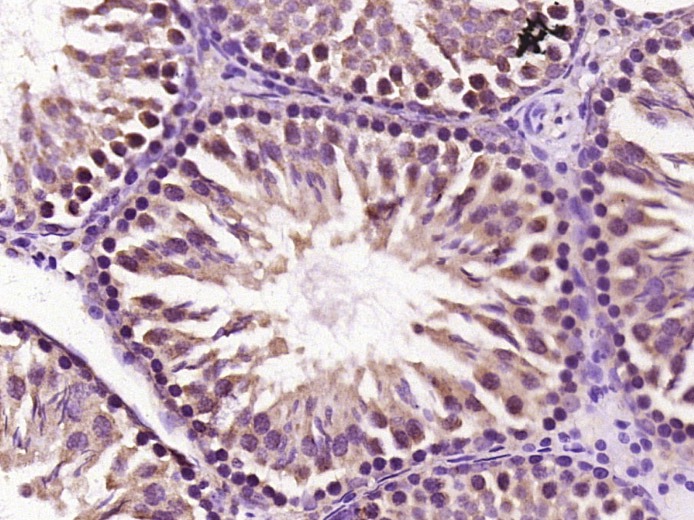Shopping Cart
Remove All Your shopping cart is currently empty
Your shopping cart is currently empty
Anti-CYP1A1 Polyclonal Antibody is a Rabbit antibody targeting CYP1A1. Anti-CYP1A1 Polyclonal Antibody can be used in IF,IHC-Fr,IHC-P,WB.
| Pack Size | Price | USA Warehouse | Global Warehouse | Quantity |
|---|---|---|---|---|
| 50 μL | $221 | 7-10 days | 7-10 days | |
| 100 μL | $373 | 7-10 days | 7-10 days | |
| 200 μL | $527 | 7-10 days | 7-10 days |
| Description | Anti-CYP1A1 Polyclonal Antibody is a Rabbit antibody targeting CYP1A1. Anti-CYP1A1 Polyclonal Antibody can be used in IF,IHC-Fr,IHC-P,WB. |
| Synonyms | Hydroperoxy icosatetraenoate dehydratase, Cytochrome P450-P1, Cytochrome P450-C, Cytochrome P450 form 6, Cytochrome P450 1A1, CYPIA1, CYP1A1 |
| Ig Type | IgG |
| Reactivity | Human,Mouse,Rat (predicted:Pig) |
| Verified Activity | 1. Sample: K562 Cell (Human) Lysate at 30 μg Primary: Anti-CYP1A1 (TMAB-00522) at 1/300 dilution Secondary: IRDye800CW Goat Anti-Rabbit IgG at 1/20000 dilution Predicted band size: 58 kDa Observed band size: 58 kDa 2. Sample: Lung (Mouse) Lysate at 40 μg Primary: Anti-CYP1A1 (TMAB-00522) at 1/300 dilution Secondary: IRDye800CW Goat Anti-Rabbit IgG at 1/20000 dilution Predicted band size: 58 kDa Observed band size: 58 kDa 3. Paraformaldehyde-fixed, paraffin embedded (rat testis tissue); Antigen retrieval by boiling in sodium citrate buffer (pH6.0) for 15 min; Block endogenous peroxidase by 3% hydrogen peroxide for 20 min; Blocking buffer (normal goat serum) at 37°C for 30 min; Antibody incubation with (CYP1A1) Polyclonal Antibody, Unconjugated (TMAB-00522) at 1:400 overnight at 4°C, followed by operating according to SP Kit (Rabbit) instructionsand DAB staining.    |
| Application | |
| Recommended Dose | WB: 1:500-2000; IHC-P: 1:100-500; IHC-Fr: 1:100-500; IF: 1:100-500 |
| Antibody Type | Polyclonal |
| Host Species | Rabbit |
| Subcellular Localization | Endoplasmic reticulum |
| Tissue Specificity | Lung, lymphocytes and placenta. |
| Construction | Polyclonal Antibody |
| Purification | Protein A purified |
| Appearance | Liquid |
| Formulation | 0.01M TBS (pH7.4) with 1% BSA, 0.02% Proclin300 and 50% Glycerol. |
| Concentration | 1 mg/mL |
| Research Background | This gene, CYP1A1, encodes a member of the cytochrome P450 superfamily of enzymes. The cytochrome P450 proteins are monooxygenases which catalyze many reactions involved in drug metabolism and synthesis of cholesterol, steroids and other lipids. This protein localizes to the endoplasmic reticulum and its expression is induced by some polycyclic aromatic hydrocarbons (PAHs), some of which are found in cigarette smoke. The enzyme's endogenous substrate is unknown; however, it is able to metabolize some PAHs to carcinogenic intermediates. The gene has been associated with lung cancer risk. A related family member, CYP1A2, is located approximately 25 kb away from CYP1A1 on chromosome 15. [provided by RefSeq, Jul 2008] |
| Immunogen | KLH conjugated synthetic peptide: human CYP1A1 |
| Antigen Species | Human |
| Gene Name | CYP1A1 |
| Gene ID | |
| Protein Name | Cytochrome P450 1A1 |
| Uniprot ID | |
| Biology Area | Drug metabolism,Cancer,Cytochromes,Hypoxia,Lipases,Drug metabolism,Cytochromes,Response to hypoxia,Cellular metabolic process |
| Function | Cytochrome P450 oxidase (commonly abbreviated CYP) is a generic term for a large number of related, but distinct, oxidative enzymes important in vertebrate physiology. The cytochrome P450 mixed-function monooxygenase system is probably the most important element of Phase I metabolism in mammals. P450s are membrane-bound, either in the inner membrane of mitochondria or in the endoplasmic reticulum of cells where they metabolise thousands of endogenous and exogenous compounds. In the liver, these substrates include toxins, drugs, and other unneeded and potentially harmful molecules. Humans have 18 families of cytochrome P450 genes and 43 subfamilies; the CYP1 family is involved in drug metabolism and includes 3 subfamilies, 3 genes and 1 pseudogene. |
| Molecular Weight | Theoretical: 58 kDa. |
| Stability & Storage | Store at -20°C or -80°C for 12 months. Avoid repeated freeze-thaw cycles. |
| Transport | Shipping with blue ice. |
| Size | Quantity | Unit Price | Amount | Operation |
|---|

Copyright © 2015-2025 TargetMol Chemicals Inc. All Rights Reserved.